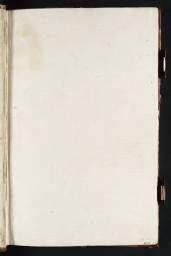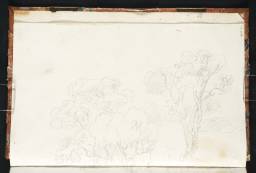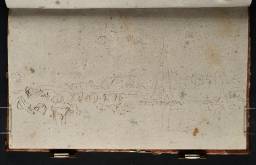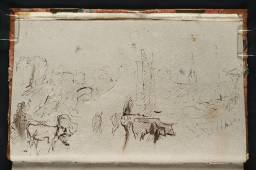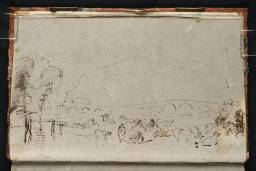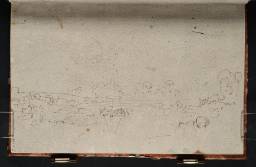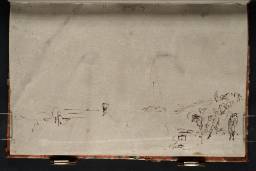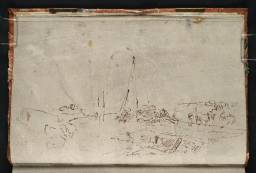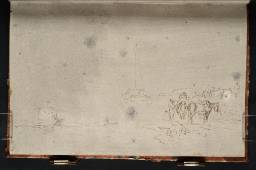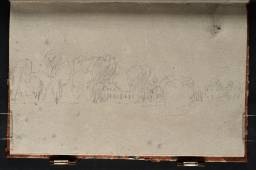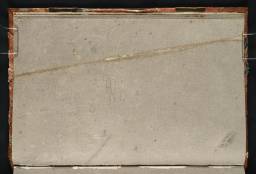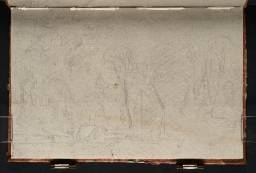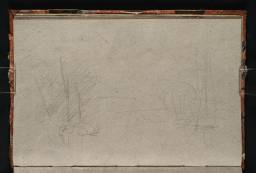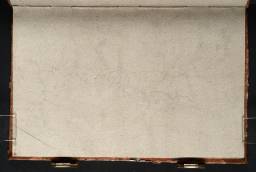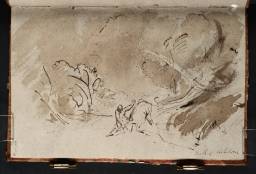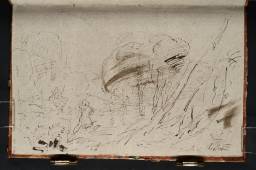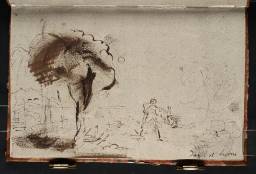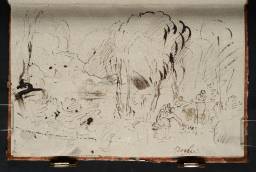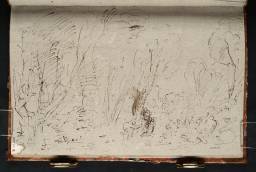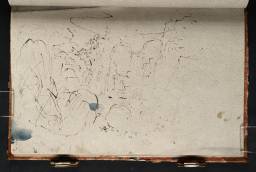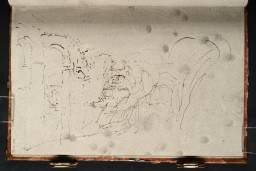Turner Bequest XCIV
Sketchbook, quarter-bound, in boards covered with blue and red marbled paper, with calf spine and corners and two brass clasps
40 leaves of white wove paper made on a double-faced mould, prepared with grey washes, and three flyleaves of white laid paper made on a single-faced mould
Approximate page size 143 x 228 mm
Most of the paper made by William Balston and the brothers Finch and Thomas Robert Hollingworth at Turkey Mill, Maidstone, Kent, and watermarked ‘1801 | J WHATMAN’. The flyleaves from an unknown maker, without watermark
Inscribed by Turner in ink ‘72 H’ on a label on the spine
Endorsed by the Executors of the Turner Bequest in ink ‘No 282 Contains 24 leaves. | in Pencil & Pen and Ink’ and signed by Henry Scott Trimmer and Charles Turner in ink ‘H.S. Trimmer’ and ‘C. Turner’ and by John Prescott Knight and Charles Lock Eastlake in pencil ‘JPK’ and ‘C.L.E.’ inside front cover. A further endorsement by John Ruskin is recorded by Finberg: ‘282. Very valuable book of pen sketches for compositions. Death of Achelous, &c., may be shown as it is. Compare 142, 228’
40 leaves of white wove paper made on a double-faced mould, prepared with grey washes, and three flyleaves of white laid paper made on a single-faced mould
Approximate page size 143 x 228 mm
Most of the paper made by William Balston and the brothers Finch and Thomas Robert Hollingworth at Turkey Mill, Maidstone, Kent, and watermarked ‘1801 | J WHATMAN’. The flyleaves from an unknown maker, without watermark
Inscribed by Turner in ink ‘72 H’ on a label on the spine
Endorsed by the Executors of the Turner Bequest in ink ‘No 282 Contains 24 leaves. | in Pencil & Pen and Ink’ and signed by Henry Scott Trimmer and Charles Turner in ink ‘H.S. Trimmer’ and ‘C. Turner’ and by John Prescott Knight and Charles Lock Eastlake in pencil ‘JPK’ and ‘C.L.E.’ inside front cover. A further endorsement by John Ruskin is recorded by Finberg: ‘282. Very valuable book of pen sketches for compositions. Death of Achelous, &c., may be shown as it is. Compare 142, 228’
Accepted by the nation as part of the Turner Bequest 1856
Exhibition history
References
This sketchbook belongs to the group used along the Thames, mainly from circa 1805. It contains sketches of the river and surroundings between Isleworth and Abingdon, several of which were used for pictures and oil sketches dating from 1805 to 1807, interspersed and blended with historical subjects.
Turner’s label on the spine, ‘72 H’ has given rise to the name ‘Hesperides’ following the emendation of the similar label on the Hesperides (1) sketchbook (Tate D05766–D05842; D05844; D40632; D40634–D40636; Turner Bequest XCIII), which is contemporary and has a uniform binding and similar content; see its catalogue notes for discussion of the name. The book is also often compared to the Studies for Pictures: Isleworth sketchbook (Tate D05491–D05617; D40568–D40574; D41505; Turner Bequest XC). All three books are thought to have been used early in Turner’s period of residence at Sion (or Syon) Ferry House, Isleworth, from 1804–5 until 1806. The comparison usually made between the books is their combination or juxtaposition of Thames views with classical and historical compositions. See Introductions to Hesperides (1) and Studies for Pictures: Isleworth for the likely influence of Turner’s friend, neighbour and fishing companion (and future Executor) Henry Scott Trimmer on these classical subjects. However, the present book has more on-the-spot sketches than the others while its historical subjects form a distinct group and do not necessarily arise from particular Thames views as they do in Studies for Pictures: Isleworth especially.
In his 1993 book, David Hill identifies many more of the Thames subjects than Finberg was able to do. He believes that Turner made them in two sequences, beginning near the front of the book, on folio 4 (D05849), at Walton and continuing to use up the pages until folio 20 (D05872), and working backwards from folio 43 (D05904), at Isleworth, to folio 34 verso (D05887), probably at Clifton Hampden. Turner left a number of leaves in the middle of the book blank and used others for the historical designs. Hill’s book arranges the contents in these two sequences. The present catalogue follows the original numbering and actual order of contents in order to avoid complicated concordances. There are in any case some anomalies in Hill’s chronology and itineraries. Turner, as usual, must have darted about from leaf to leaf as subjects do not follow the actual course of the river; Clifton Hampden probably also appears in a sketch inside the back cover (D40637); and if two views of ruins on folios 19 and 20 (D05871, D05872), which Hill does not identify, depict the former Cliveden House, they would lie outside either of his two series.
The views of the upper reaches of the Thames around Abingdon, Culham and Sutton Courtenay as well as Clifton Hampden indicate a trip up-river perhaps as far as Oxford. Hill suggests one lasting a month or more, in September or October 1805.1 While noting that some of these subjects dovetail with others drawn, presumably at the same time, in the larger Thames from Reading to Walton sketchbook (Tate D05905–D05953; D40274;D40344–D40345; D40382; Turner Bequest XCV), Hill comments on their brevity or even ‘unintelligibility’and thinks that their ‘disengagement’ indicates that Turner was winding down at the end of this trip.2 Of folio 35 verso (D05889) depicting trees by water, probably near Sutton Courtenay with Wittenham Clumps in the distance, he comments: ‘Scrappy enough to wonder why Turner made it.’ However, the view seems to be related to another on 37 verso (D05893), showing the same group of larger trees and pollarded willow at the centre but extended further to the right, and also to 36 verso (D05891) which perhaps follows the river still further to the right.
Probably these quick sketches were made in the course of a walk along the same short stretch of riverbank, or perhaps from a boat. In fact Turner was sufficiently attracted to this view, especially as seen in 37 verso, to adopt it for his contemporary, unfinished oil Washing Sheep (Tate N02699).3 Hill makes this connection, but while suggesting 37 verso is of Sutton Courtenay he also proposes that the oil is of scenery near Dorchester; previously, it had been suggested that the oil represented the River Wey.4 Sutton Courtenay seems more likely, and there may be a further connection between a sketch of ‘Sutton Mills’ on folio 38 verso (D05895) and a similar unfinished oil Weir and Cattle (Tate N02705) for which a location on the Wey had also been suggested.5 Far from disengaging, it is arguable that Turner was paying special attention to this stretch of river and its trees, pollards and weirs but with his focus mainly on oils; it is possible that a third oil, House Beside the River, with Trees and Sheep (Tate N02694)6 depicts the same locale, and even the Mill House at Sutton Courtenay, though for this too a Wey subject has been proposed.
Three finished paintings have their origins in this book. Turner used a group of sketches made around Walton Bridges for his two pictures of the subject. Folio 4 in particular but presumably also 6, 7, 7 verso and 8 (D05849, D05853, D05855, D05856, D05857) contributed to the downstream Walton Bridges perhaps exhibited at Turner’s Gallery in 1806 and certainly bought by Sir John Leicester in 1807 (the Loyd Collection);7 5 verso served for the upstream view in Turner’s Gallery the following year and bought by the Earl of Essex (National Gallery of Victoria, Melbourne).8 There are sketches related to Abingdon (Tate N00485),9 now thought to have been in Turner’s Gallery in 1806 or 1807, on folio 4 verso and 5 (D05851, D05852); the latter, of a crane for unloading timber, was actually drawn at Walton but Turner moved the motif into his picture of Abingdon, where as Hill observes, it may be receiving deliveries for the construction of the town prison.
The historical sketches on folios 13–18 (D05865–D05870) are of subjects from Ovid’s Metamorphoses. They depict a closely related series of events in Book 9, firstly the ‘Deaths’ of Achelous, Nessus and Lichas from the story of Hercules and Deianira, then ‘Dryope’ and lastly the birth of Adonis. They are technically different from the other drawings in the book, having additions in wash.
Technical notes
How to cite
David Blayney Brown, ‘Hesperides (2) sketchbook c.1805–7’, sketchbook, February 2010, in David Blayney Brown (ed.), J.M.W. Turner: Sketchbooks, Drawings and Watercolours, Tate Research Publication, December 2012, https://www

